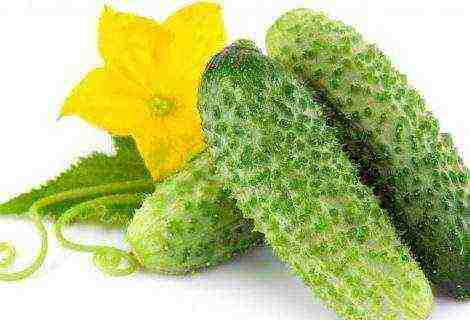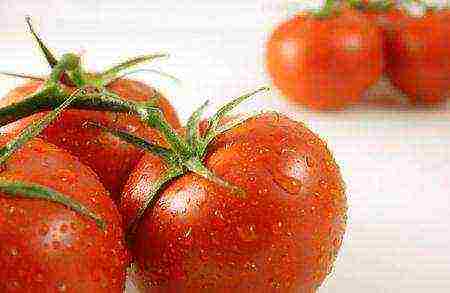Content
- 1 Self-fertile varieties of cherries
- 2 Early varieties of cherries
- 3 Medium ripening cherry varieties
- 4 Late varieties of cherries
- 5 Large varieties of cherries
- 6 Low-growing (dwarf) cherry varieties
- 7 The best cherry varieties for the southern regions of Russia
- 8 The best cherry varieties for the northern regions
- 9 The most delicious cherry varieties for Siberia and the Urals
- 10 The best cherry varieties for the Moscow region, description and care
- 11 1. Volochaevka
- 12 2. Zhivitsa
- 13 3. Tamaris
- 14 4. Chocolate girl
- 15 5. Spunk
- 16 Types of cherries and features of fruiting
- 17 Popular cherry varieties for central Russia
- 18 The best winter-hardy cherry varieties for the middle lane
- 19 The best varieties of the largest cherry
- 20 What variety of cherries can be planted on the site (with video)
- 21 The nicest varieties of cherry wood
- 22 What varieties of cherries are best planted in the middle lane
- 23 Description of the most delicious varieties of cherries
All varieties of cherries differ among themselves in various ways, whether it is the ripening time, the size of the fruit or the region of growth. The most frost-resistant cherries are those grown in the northern regions. (Ob, Ashinskaya, Blizzard), but the most productive and sweetest varieties grow in the south of the country (Lyubskaya, Shpanka, Garland). Cherries, early ripening the most stable, but their taste is much more sour (Shokoladnitsa, Molodezhnaya), medium ripening varieties are the golden mean (Vladimirskaya, Zhukovskaya, Turgenevka). Another sign is the presence of flowers of both sexes, that is, self-fertility (Apkhutinskaya, Pamyat Yenikiev). To choose the most suitable cherry variety, you need to know all their characteristics.
Self-fertile varieties of cherries
Self-fertile varieties include cherries that no additional pollination required, and they independently set both male and female flowers.
Apukhtinskaya
A medium-sized tree on which large and tasty heart-shaped fruits grow. The Apukhtinskaya variety begins its fruiting already in the second year after planting, refers to late ripening, the ripening of the crop falls in mid-August. The tree has good resistance to frost and drought, but it is also susceptible to fungal diseases.
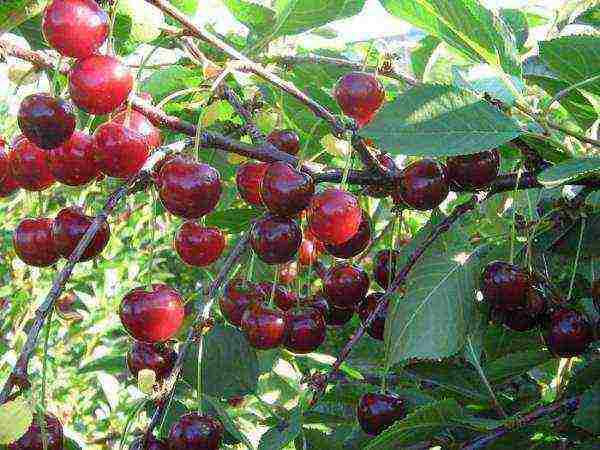 Cherry variety Apukhtinskaya
Cherry variety Apukhtinskaya
Memory of Yenikiev
The tree grows up to 3 meters in height, the crown is of medium density, spherical in shape. Fruit weight reaches 5 gramsso they can be considered large. The shape of the berries is oval, the color is dark red. Cherry pulp Yenikiev's memory is very tasty and juicy. The variety is distinguished by the presence of a large bone... The tree begins to bear fruit already at 3-4 years of age, the period of full ripening of the crop falls at the end of June. Up to 15 kilograms of fruit can be harvested from one cherry.... It has medium resistance to frost and drought.
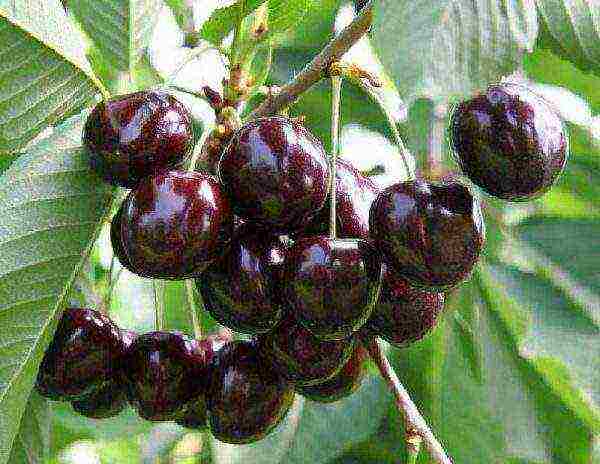 Cherry in Memory of Yenikeev
Cherry in Memory of Yenikeev
Also self-fertile varieties of cherries include Garland, Brunette, Cinderella, Shokoladnitsa, ErdiBetermo, Ksenia, Nochka, Vstrecha, etc.
Early varieties of cherries
Cherry varieties that ripen between early June and mid-July are called early cherry varieties.... Their berries are less sweet, and the trees have good frost resistance.
Chocolate girl
This cherry tree is of medium height, with a crown shape reminiscent of an inverted cone. The berries are distinguished by their sour taste and maroon color. The pulp is a deep red shade, dense, with an easily detachable bone... The Shokoladnitsa variety tolerates frost and drought well, is resistant to many diseases, and is self-fertile. Brings a stable harvest.
 Cherry Shokoladnitsa
Cherry Shokoladnitsa
Spunk
This variety is a cherry-cherry hybrid. A tall tree with freely growing branches resembles a ball in its shape. In addition, the attachment of branches to the tree is rather weak, so when the crop appears, there is a risk that they will begin to break. The taste of berries is sweet and sour, on average, their weight is 4 grams... Fruit color is dark red, rounded-flattened shape. The first crop of Shpanka brings in 6-7 years of life, but at the age of 20 you can get up to 60 kilograms of cherries from a tree. Fruiting occurs from late June to early July... The variety is highly resistant to frost and drought and needs pollinators.
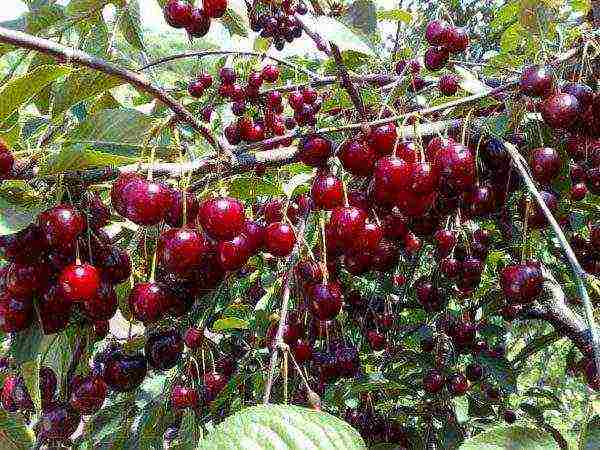 Cherry varieties Shpanka
Cherry varieties Shpanka
Youth
Shrub cherry, with a low, slightly drooping crown. The fruits of the Molodezhnaya variety are large in size, their weight can reach 4.8 grams, the skin and pulp have the same maroon color. The stone separates well, and a slight sourness is felt in the taste of the cherries themselves, such berries are perfect for preservation and freezing. The first crop appears on a 5-year-old tree, fruiting mainly occurs on last year's wood... Molodezhnaya is a frost-resistant variety. Has an average disease resistance.
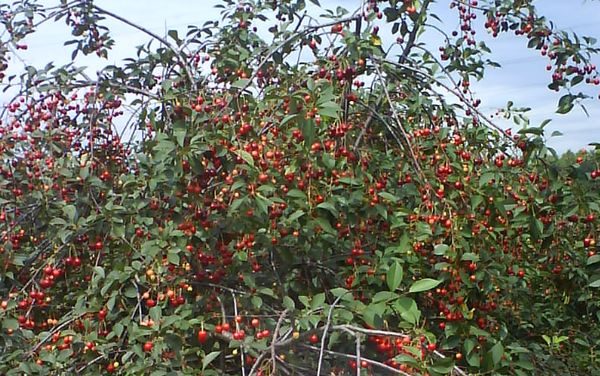 Shrub self-fertile cherry variety Molodezhnaya
Shrub self-fertile cherry variety Molodezhnaya
Miracle cherry
Arboreal cherry with medium vigor. The crown of the tree needs constant formation, with a free form of growth, it looks like a cone, and the fruits will accumulate at the very top. The taste of berries is dessert, sweet, in all their external characteristics they resemble cherries, can reach a weight of 9.5 grams. The variety is self-fertile and needs pollinators. The tree begins to bear fruit as early as 3 years of age, while bringing a large, stable harvest. You can harvest the fruits already at the beginning of June. Miracle cherry is resistant to frost and most diseases.
 Variety Miracle cherry
Variety Miracle cherry
Baby
The tree is of medium height and spherical in shape. It bears beautiful dark red fruits with a pleasant sweet and sour taste, the stone is easily separated from the pulp. The shape of the berries is round, evenly flattened, the weight reaches 5 grams... Variety Malyshka Differs in good transportability, immunity to fungal diseases and frost resistance. Productivity is inferior to other varieties, from one tree you can get 17 kilograms of cherries. Their full maturity falls at the end of June.
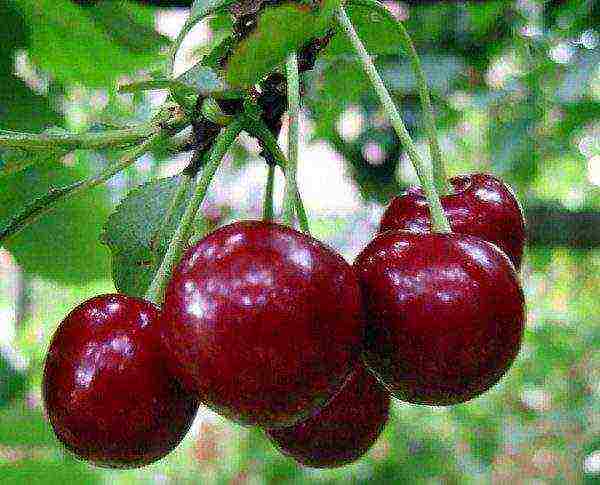 Cherry variety Baby
Cherry variety Baby
There are also other early ripening varieties of cherries. For example, Memory, Bulatnikovskaya, Enikeeva, Bagryanka, Sania, Vasilievskaya.
Medium ripening cherry varieties
Middle-early cherries are called cherries that ripen in the middle of summer, they have the best taste.
Vladimirskaya
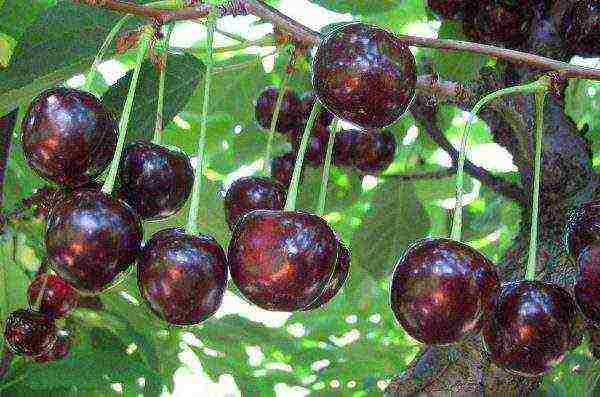 Cherry fruits Vladimirskaya
Cherry fruits Vladimirskaya
Vladimirskaya - one of the oldest varieties grown in the central regions of Russia. Bushy tree, grayish bark... The branches grow downward, so the shape of the crown is called weeping. 5-7 flowers of delicate white color are collected on one inflorescence. Leaves of a matte green shade, elongated, gradually sharpening towards the base and apex, the edge is double-serrate. Fruits are sweet and sour, slightly fibrous, well suited for all forms of processing. The color of the skin is dark red, almost black, the weight of the berries does not exceed 3.7 grams, the shape is round-flattened. The first fruiting occurs in the 3rd year of life., cherry ripening occurs at the end of July. This variety tolerates winter cold well, but spring frosts can completely destroy the inflorescences, and, accordingly, the entire crop. It grows best in central Russia, with good care it can bear 25 kilograms of fruit. In the northern regions, the yield drops sharply to 6-7 kilograms.... Vladimirskaya needs pollinators and additional protection from diseases and pests.If the berries are not picked in time, they will begin to crumble very quickly.
Zhukovskaya
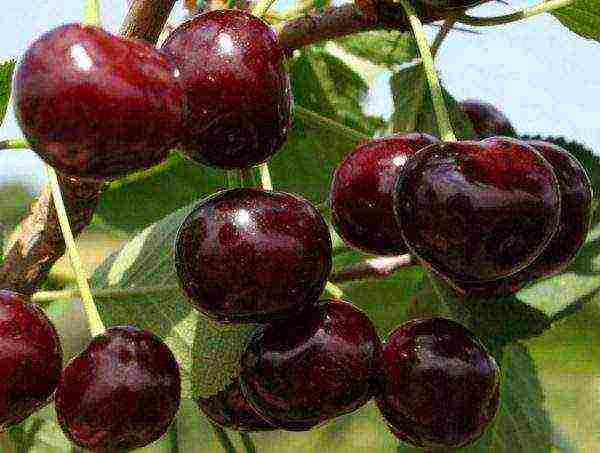 Cherry variety Zhukovskaya
Cherry variety Zhukovskaya
Cherry grows up to 2.5 meters, the crown of the tree is spreading, but rare. Leaves are narrow, oval, dark green in color. Forms inflorescences of 3-4 flowers, medium-sized with rounded petals. Fruiting occurs on last year's annual wood... Most often, the berries are located singly, sometimes in two. Cherry varieties Zhukovskaya medium size, up to 4 grams, dark red, heart-shaped. The pulp is tender, juicy, with a dessert taste. Disease resistance is average.
Kharitonovskaya
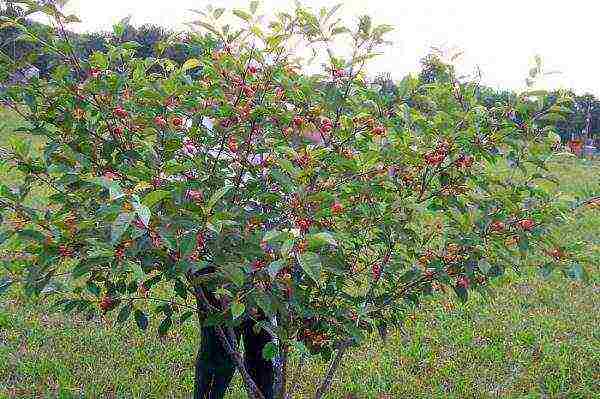 Cherry variety Kharitonovskaya
Cherry variety Kharitonovskaya
The tree grows to medium size, the flowers are large, white. The berries themselves are evenly rounded, the skin is bright red, the flesh is orange. They have a sweet and sour taste, the stone is easily separated... Good immunity to various diseases, normal frost resistance. The Kharitonovskaya variety needs additional pollination.
Turgenevka
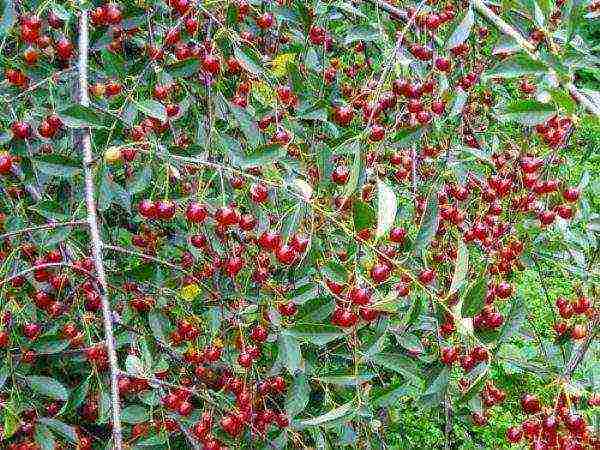 Cherry varieties Turgenevka
Cherry varieties Turgenevka
A cherry tree of this variety grows up to 3 meters, forms inflorescences of 4 white flowers. Fruiting occurs on bouquet twigs. Berries are broadly heart-shaped, large in size, weighing up to 6.5 grams... The skin color is dark red, the pulp is juicy, sour-sweet, the taste is normal. The first harvest ripens at 5-6 years of age, full ripening of fruits occurs in early July. Turgenevka tolerates winter frosts well, but may die when spring frosts appear... Possesses high resistance to diseases, requires pollinators. The variety produces a good, stable yield.
Morozovka
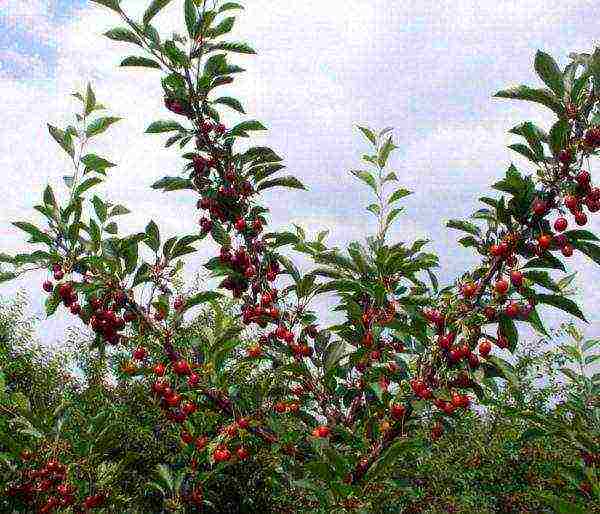 Cherry with fruits grade Morozovka
Cherry with fruits grade Morozovka
The tree grows medium in size, the crown is wide, spreading. Fruiting occurs on bouquet twigs, the berries are round in shape with a fossa at the stalk, the weight can reach 5.5 grams. The skin is maroon in color, the pulp is juicy, dessert taste with an easily detachable bone... Such berries are suitable both for fresh consumption and for processing, they are well transported. The tree begins to bear fruit at the age of 3 years; the fruit of the Morozovka variety ripens at the end of July. The yield is stable, up to 500 kilograms per hundred square meters... The variety is resistant to frost, drought and disease. Needs pollinators.
Also, the average ripening period is possessed by the varieties Radonezh, Vstrecha, Toy, Nochka.
Late varieties of cherries
Late varieties are the last to ripen, in late summer and early autumn..
Lyubskaya
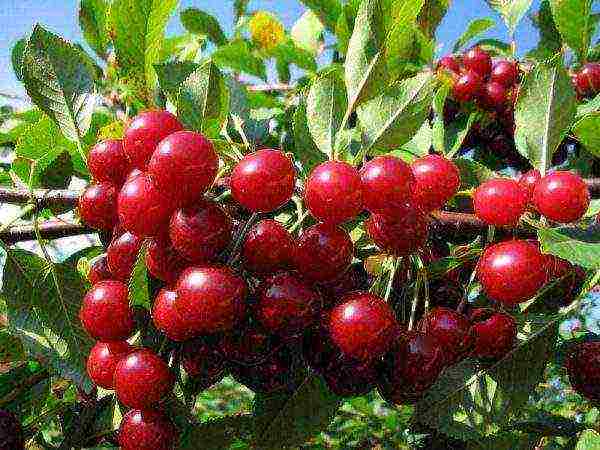 Harvest of cherries of the variety Lyubskaya
Harvest of cherries of the variety Lyubskaya
The variety is intended for cultivation in central and southern Russia, very picky about soil fertility and quality of care. Produces a large crop with blood-red, transportable fruits with a mediocre taste... These berries are ideal for processing. The tree is self-fertile, but with additional pollination it gives higher yields. A young tree bears up to 26 kilograms of fruit, and an adult up to 60. Lyubskaya does not have frost resistance, it is often exposed to various diseases.
Generous
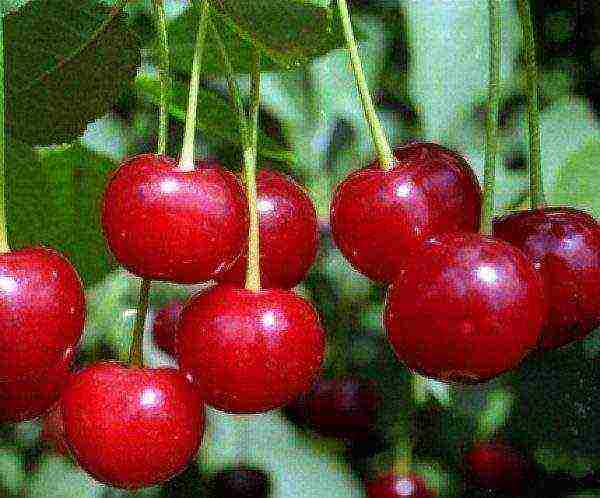 Cherry variety Generous
Cherry variety Generous
Bushy cherry with upturned shoots. The weight of one cherry is about 4 grams, its shape is round, the color is bright red. Pulp with good taste, the stone is easily separated. The presentation of the berries is at the highest level, they are resistant to cracking. Variety Generous gives an annual, bountiful harvest, ripens in autumn... The tree gives its first cherries as early as 3-4 years. Generous is distinguished by high frost resistance, it can easily endure even spring frosts, and the variety does not lend itself to attacks by pests, it tolerates drought well. Susceptible to diseases, especially fungal diseases.
Robin
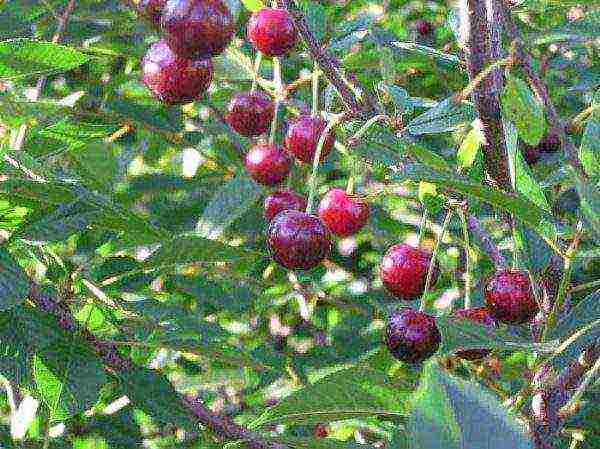 Cherry variety Malinovka
Cherry variety Malinovka
A tree of medium height with a spherical crown. Leaves with a wide plate, glossy, green, crenate edge. The cherries are small, on average, the weight of one berry is 3-3.5 grams, the shape is round... The taste is sweet and sour, pleasant, the pulp is dense. The variety gives an annual, bountiful harvest that ripens in early August.The robin needs additional pollinators and protection from disease. Frost resistance - medium.
Other varieties of late-ripening cherries are Zhuravka, Polevka, Rubinovaya, Lotovaya, Rusinka, Gorkovskaya.
Large varieties of cherries
Cherry varieties with large dessert berries are not inferior to sweet cherries in their taste. But compared to other varieties, they are whimsical to climatic conditions and quality of care.
Consumer goods Black
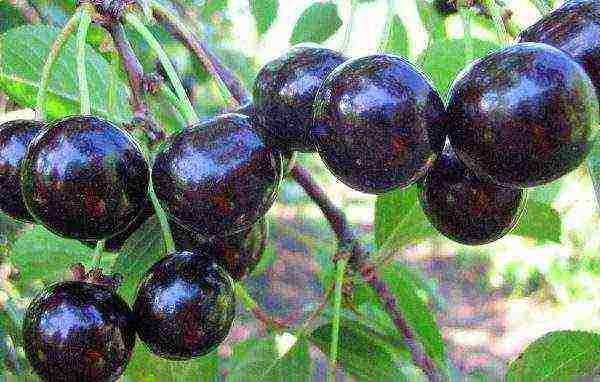 Cherry variety Consumer goods Black
Cherry variety Consumer goods Black
A low-growing tree with very tasty berries with a dark skin of almost black color. The pulp is juicy, tender, with an easily detachable bone. The fruits ripen Consumer goods Black in early June, the yield of the variety is moderate... Has a weak resistance to frost. The tree needs additional pollination.
Volochaevka
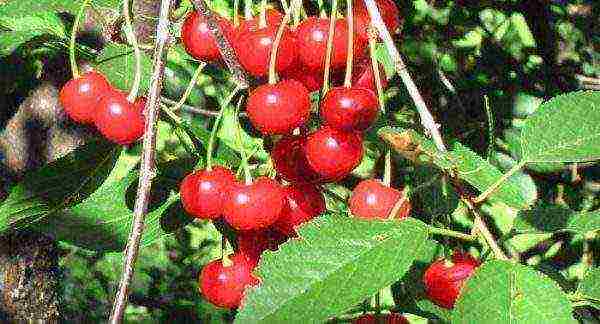 Cherry Volochaevka
Cherry Volochaevka
A medium-sized tree is capable of producing an annual harvest. The berries are sweet, juicy with firm pulp and easily removable pits. Ripens in mid-July. The variety does not tolerate frost well, in the rainy season there is a risk of rot... Volochaevka forms both female and male flowers, self-fertile.
A meeting
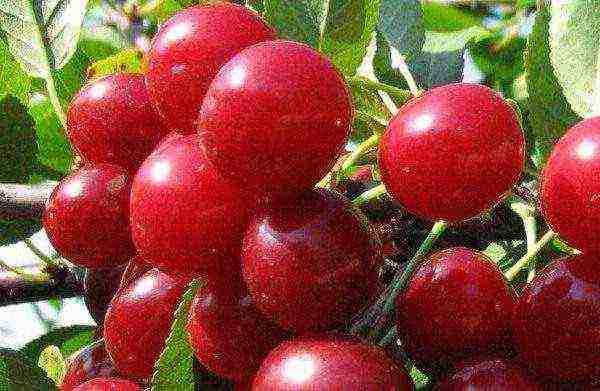 Cherry variety Meeting
Cherry variety Meeting
A small tree, the weight of the fruits of which exceeds the mark of 10 grams. The berries are bright red, with a tender and juicy pulp... The harvest of the Vetska variety is stable and annual, ripening falls on the 20th of June. The variety tolerates frost and drought well, and is resistant to fungal diseases.
Also, varieties with large fruits include Molodezhnaya, Dessert Morozova, Pamyat Yenikeev, Podbelskaya, Minx, Toy, etc.
Low-growing (dwarf) cherry varieties
Trees of such varieties grow no higher than 2.5 meters.... They are very convenient for breeding and harvesting, therefore they are very popular among gardeners.
Anthracite
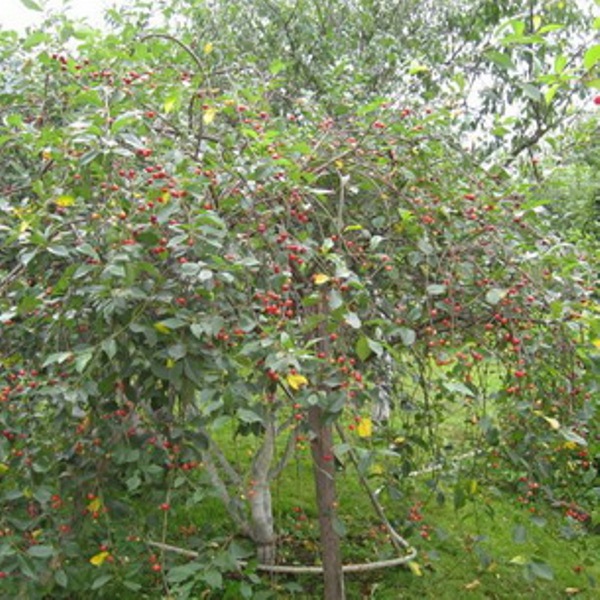 Common cherry Anthracite
Common cherry Anthracite
A bushy cherry with a wide crown, its maximum growth is 2 meters. The skin of the berries is dark, almost black in color, the pulp is blood red.... Fruit weight is 4-5 grams, taste is good. Cherries ripen in mid-summer and are well transported. The Anthracite variety is resistant to frost, drought and fungus.
Bystrinka
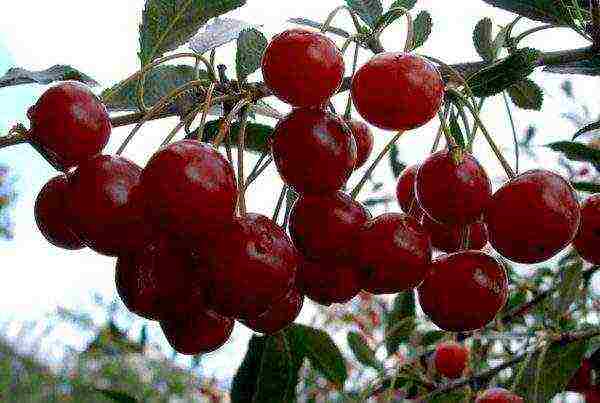 Low-growing cherry variety Bystrinka
Low-growing cherry variety Bystrinka
The small tree forms a spherical crown. Burgundy berries, with the same color pulp, their weight ranges from 3.5-4.2 grams, well transported. The taste is sweet and sour. The harvest period is early July... The resistance of the Bystrinka variety to frost is average. There is a risk of damage from moniliosis.
Mtsenskaya
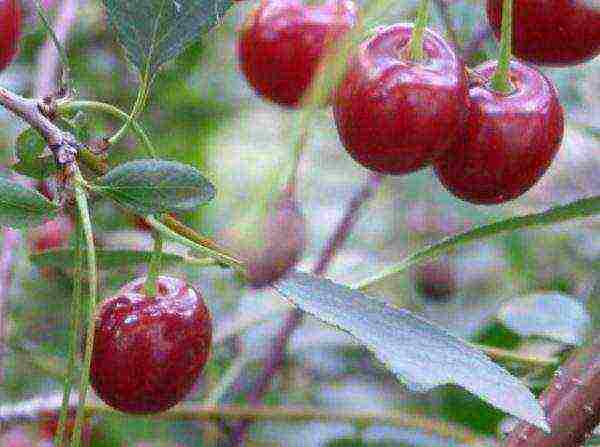 Cherry grade Mtsenskaya
Cherry grade Mtsenskaya
The tree rarely exceeds 2 meters in height, the crown is oval. Average, one berry weighs 4 grams, skin color is maroon... Most often, the fruits of the Mtsenskaya variety are processed. The trees are characterized by good resistance to frost, drought and most diseases. They also have an attractive appearance, which is why they are often used in landscape design.
There are many undersized varieties of cherries, these include Lyubskaya, Molodezhnaya, Memory Mashkin, Shokoladnitsa, Vladimirskaya, Tamaris and Saratov baby.
The best cherry varieties for the southern regions of Russia
Such varieties are distinguished by excellent taste, low or medium frost resistance. Their cultivation is possible only in warm climatic conditions.
Sasha
On average, the tree grows up to 3-4 meters, the foliage is average. Fruiting occurs on annual shoots. The fruits are large, juicy, red. They are distinguished by excellent taste. The Sasha variety is frost-resistant, rarely exposed to diseases.... The first fruiting occurs in the 5th year of life, early ripening.
Garland
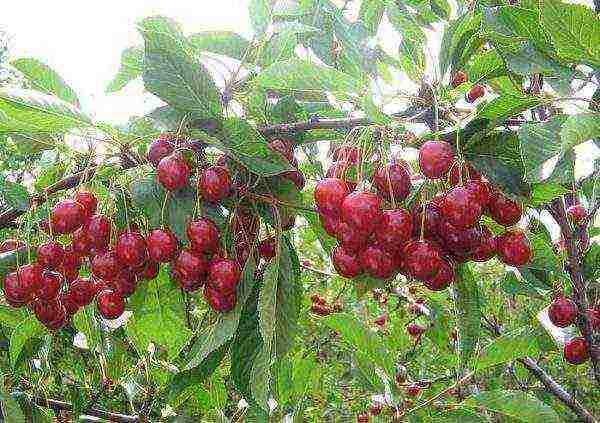 Cherry variety Garland
Cherry variety Garland
The growth of the tree is 3 meters, a large amount of foliage is formed on the branches. The Garland variety is distinguished by the presence of inflorescences, of which 5 fruits appear. The berries are very large, juicy and tasty, the skin color is slightly darker than the flesh. The first crop can be harvested in mid-June as early as the 3rd year of life... The tree does not need additional pollination.
Also, for the southern regions, varieties such as Lyubskaya, Shpanka, Shokoladnitsa are suitable.
The best cherry varieties for the northern regions
Ashinskaya
 Cherry grade Ashinskaya
Cherry grade Ashinskaya
It is considered the best variety for the northern regions. A low-growing shrub, whose growth does not exceed 1.5 meters, can tolerate frosts down to -55 degrees... Also drought tolerant. Berries are dark in color, with dense pulp, slightly astringent, sweet and sour taste. The bone is small, easy to remove. Flowering occurs from the beginning of April, the shrub gives its first harvest at 4 years of age.
Ob
 Cherry Ob
Cherry Ob
A short shrub that is only 130 centimeters tall. Fruiting occurs on annual growths. Berries are small, dark red in color, with a good taste and a small, well-separated seed... Fruits ripen in mid-July. The Ob is capable of withstanding severe frosts and drought, but is highly susceptible to pest attacks. The variety is self-fertile and does not need pollination.
Altai swallow
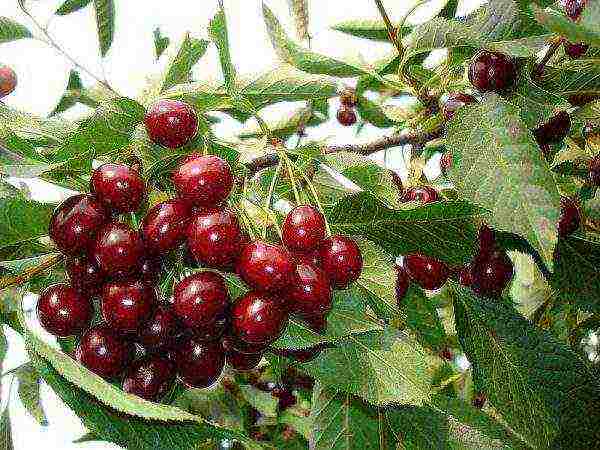 Cherry variety Altai swallow
Cherry variety Altai swallow
A low-growing bush, no more than 150 centimeters high. The berries are round in shape and medium in size, distinguished by excellent taste and juiciness... Fruit ripening occurs in mid-July. The yield of the variety is very different from the trees growing in the southern regions, and is only 5 kilograms. The Altai swallow tolerates frost and drought well, and is immune to many diseases. It is also a pollinator for many cherry varieties.
For the northern regions, the Novoaltaiskaya and Metelitsa varieties may be suitable.
The most delicious cherry varieties for Siberia and the Urals
Such varieties of cherries adapt well to the changeable climate of Siberia and the Urals, besides, they are distinguished by good yield and taste.
Ural ruby
 Cherry shrub Ural ruby
Cherry shrub Ural ruby
A shrub, whose growth is 1.5 meters, the crown is wide, the branches are weeping, growing downward. The leaves are wide, shiny, dark green in color, their shape resembles a boat. Fruits weigh only 3-4 grams, round in shape, dark red, juicy, sweet and sour taste... Ripen in mid-August. The variety is self-fertile, but it has a stable and good yield; an adult tree bears up to 10 kilograms of berries.
Lighthouse
 Siberian cherry variety Mayak
Siberian cherry variety Mayak
Lighthouse - a bush 2 meters high with a wide spreading crown and leaves folded into a boat. The Siberian variety is self-fertile, but when planted next to such varieties as Vole and Schedra, it gives the most abundant yields. Fruits gain weight up to 6 grams, dark red, sour-sweet taste. The crop can be harvested in early August, on average, one bush gives from 5 to 15 kilograms of fruit.
Also for these territories, the varieties Standard Ural, Schedra, Sverdlovchanka, Zagrebinskaya and Gridnevskaya are suitable.
The best cherry varieties for the Moscow region, description and care
The varieties that are best suited for the Moscow region must have good resistance to frost, and be unpretentious to the composition of the soil, a description of which can be found below.
Early varieties
From the category of early varieties of the Moscow region the varieties Molodezhnaya and Chudo cherry are best suited.
Among the mid-season varieties, one can distinguish Turgenevka, Excellent Venyaminova and Griot Moskovsky.
Griot of Moscow
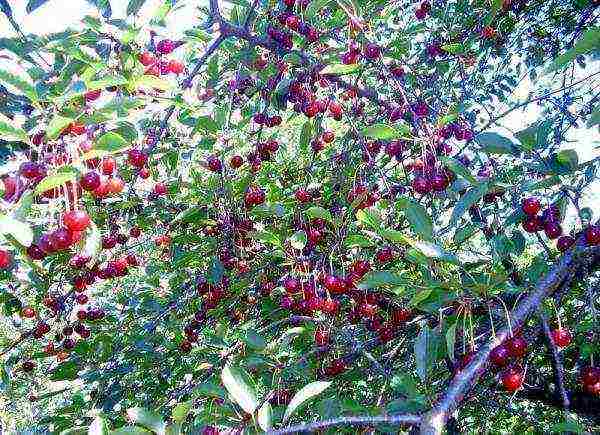 Cherry for Moscow region Griot Moskovsky
Cherry for Moscow region Griot Moskovsky
A tree with a spherical crown and matte leaves. The berries reach 3.5 grams in their weight, the taste characteristics are at the highest level, the fruits are suitable for various types of processing... Such a variety ripens in mid-July, the yield is above average, from a hundred square meters you can get up to a ton of cherries. Resistance to winter cold and return frost is excellent. Undergoes coccomycosis and monial burn.
Late varieties
Among the varieties of late ripening Zhukovskaya has recommended herself in the best way.
The undersized (dwarf) cherry varieties for the Moscow region include Molodezhnaya, Mayak, Tamaris, Bystrinka, Memory Mashkin and Malyshka.
Tamaris
The crown of the tree is small, rounded. Fruits are dark red in color with sparse brown spots. The pulp of the berries is juicy, the taste is sour. Cherries can be used both for fresh consumption and for various processing, the transportability of the fruits is average. You can harvest the crop in early August. The variety has good frost and drought resistance.
In memory of Mashkin
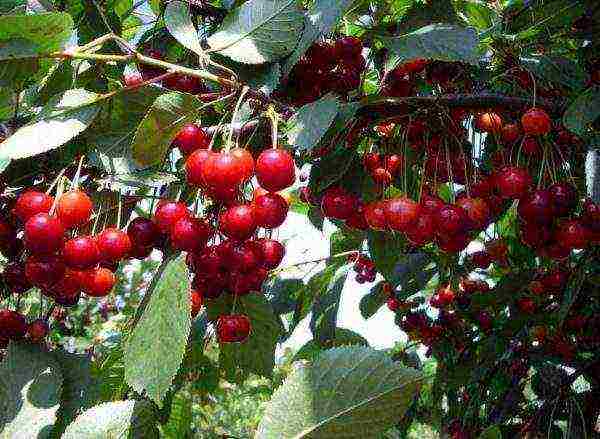 Cherry variety in Memory of Mashkin
Cherry variety in Memory of Mashkin
The crown of the tree is spreading, drooping, spherical in shape. The fruits are large in size, grow up to 5 grams, with their own dessert taste, they often become an adornment of any garden. Maturation occurs in mid-July... Resistance to frost and sore immunity is average.
Self-fertile varieties
The most popular self-fertile varieties for the Moscow region are Apukhtinskaya, Lyubskaya, Zagorievskaya, Volochaevka, Shokoladnitsa, Vstrecha, Garland and Cinderella.
Cinderella
Medium-sized tree, forming fruits weighing 4 grams, rounded oval and light red in color, sweet and sour taste. The harvest ripens in mid-July, from one tree you can get up to 15 kilograms of berries... The frost resistance of the tree itself and of the flower buds is excellent. The variety does not require additional protection against fungal diseases.
Breeders have bred a huge number of cherry varieties, which makes it possible to grow this crop in all corners of Russia. For the most part, all trees have good to medium frost resistance and bear sweet and sour fruits.... Each gardener can choose and plant the cherry that will decorate his particular plot.
Many are accustomed to the fact that cherries are sour. But not everyone knows that there are varieties with very juicy and very sweet fruits. Taste them - and you will forever change your attitude towards cherries for the better!
It is noteworthy that these varieties were appreciated not only for the sweet taste of rather large berries. They are also distinguished by high yield and excellent presentation. These plants can be cultivated in central Russia and enjoy delicious fruits every year.
1. Volochaevka
This is a hybrid of popular cherry varieties - Lyubskaya and Vladimirskaya. With proper care of the plant, about 15 kg of juicy berries can be harvested from one tree annually.
The tree is medium-sized, with a rounded crown of medium density. The leaves are dark green, shaped like an inverted egg. Fruits are medium in size, deep red in color. Sweet to taste, with a slight sourness.
Inside the berry there is a small bone, which is easily separated from the very juicy and aromatic pulp, which has an excellent dessert taste.
This variety has a drawback: it has an average frost resistance and, under unfavorable growing conditions, can be affected by fungal diseases. In a rainy summer, he often suffers from coccomycosis.
| Entering fruiting | Tree height (m) | Fruit weight (g) | Harvest | Pollinating varieties |
| 3-4 years after planting | 3-3,5 | 4,5 | July 20-25 |
Self-fertile variety - in pollinators does not need |
2. Zhivitsa
This is a hybrid of cherry and sweet cherry, bred in Belarus. The mid-early variety Zhivitsa fell in love with many gardeners for its excellent frost resistance and plant resistance to coccomycosis and monilial burn.
The tree is medium-sized, with a rounded crown. The fruits of the so-called sweet cherry are medium-sized, round, dark red. They have a small bone, which separates well from the juicy pulp of a dark red color with a pleasant sour-sweet taste. The juice is also distinguished by its rich color and good taste.
It is thanks to crossing with cherries that this hybrid has sweeter berries than ordinary cherries. And besides, they contain many useful organic acids.
| Entering fruiting | Tree height (m) | Fruit weight (g) | Harvest | Pollinating varieties |
| 4 years after planting | 3 | 3,7 |
End of June - early July |
Seedling No. 1, Novodvorskaya, Vianok; cherry varieties, blooming at the same time with Zhivitsa (for example, Narodnaya, Syubarovskaya) |
3. Tamaris
The closest relative is the black consumer goods cherry, which also has good taste. However, this variety is self-fertile (does not pollinate on its own) and gives a small yield.
Therefore, Tamaris is a more improved version, which differs in rather large oval-shaped berries with a very juicy and tender pulp (with a slight sourness) of a dark red color.
The tree itself is of short stature, but has a spreading crown of a reverse pyramidal shape. For this reason, the plant is easy to care for and there is no need to build a high ladder when harvesting. And another advantage of this variety is that it is resistant to frost and coccomycosis.
Despite the fact that the Tamaris variety is self-fertile, it is recommended to plant such pollinator varieties as Turgenevka, Zhukovskaya, Lyubskaya next to it. This will significantly increase yields.
| Entering fruiting | Tree height (m) | Fruit weight (g) | Harvest | Pollinating varieties |
| 2-3 years | 1,7-2 | 4,3-5 |
End of July - early August |
Self-fertile variety - in pollinators does not need |
4. Chocolate girl
This variety got its name from the very beautiful, chocolate color of the berries. The plant quickly gained popularity not only for the excellent taste of the fruits, their attractive appearance, but also for good winter hardiness, as well as short stature.
But keep in mind that a rich harvest can be harvested if the tree receives enough light. Therefore, for a seedling it is best to choose a place on the southern side of the plot and not "settle" tall trees near that will create shade. Then from one adult cherry tree you can collect about 12 kg of delicious berries.
The fruits of the Shokoladnitsa variety have a rounded shape and a maroon (almost black) color with a glossy sheen. The pulp is red, juicy, sweet and sour. Moreover, it has a cherry flavor.
To get a more generous harvest, Shokoladnitsa should be planted next to Griot cherries or Vladimirskaya and Sklyanka cherries. This will improve the pollination of trees.
| Entering fruiting | Tree height (m) | Fruit weight (g) | Harvest | Pollinating varieties |
| 4 year | 2,1-2,5 | 3,5-4 |
Second half july |
Self-fertile variety - in pollinators does not need |
5. Spunk
Spanka is a cherry / sweet cherry hybrid that comes in several varieties. The most popular are Shpanka dwarf, Shpanka early, Shpanka large-fruited, Shpanka Kursk, Shpanka Shimskaya, Shpanka Bryansk and Shpanka Donetsk. Basically, these are zoned varieties, which practically do not differ in their characteristics. In central Russia, large-fruited Shpanka is usually grown.
This is a vigorous tree with a dense crown of reverse pyramidal shape. The fruits are rounded, slightly flattened and dark, maroon-brown in color. They, like cherries, hang on the tree in garlands or along the entire one-year growth. The pulp of the berries is sweet, with a hint of sourness, light yellow in color. The juice is almost transparent.
Shpanka tolerates severe winters with frosts down to -35 ° C and drought. And also, as a rule, does not suffer from coccomycosis.
This variety is considered self-pollinating, but the level of self-fertility is no more than 10%, therefore, to increase yields, it is recommended to plant pollinating varieties next to it.
| Entering fruiting | Tree height (m) | Fruit weight (g) | Harvest | Pollinating varieties |
|
5-6 years later after landing |
Until 6 | 4-5 |
End of June - early July |
Griot Ukrainian, Griot Ostheim |
We hope our detailed description will help you choose the right sweet cherry variety, because according to the reviews of experienced gardeners, all of the listed plants are good. And with proper care, the tree will certainly respond with a rich harvest of tasty, juicy, aromatic and sweet berries.
Cherry has always occupied an honorable second place after apple among fruit crops.In this article, we will analyze the best cherry varieties for central Russia, as well as a description of trees of early, middle and late ripening.
Types of cherries and features of fruiting
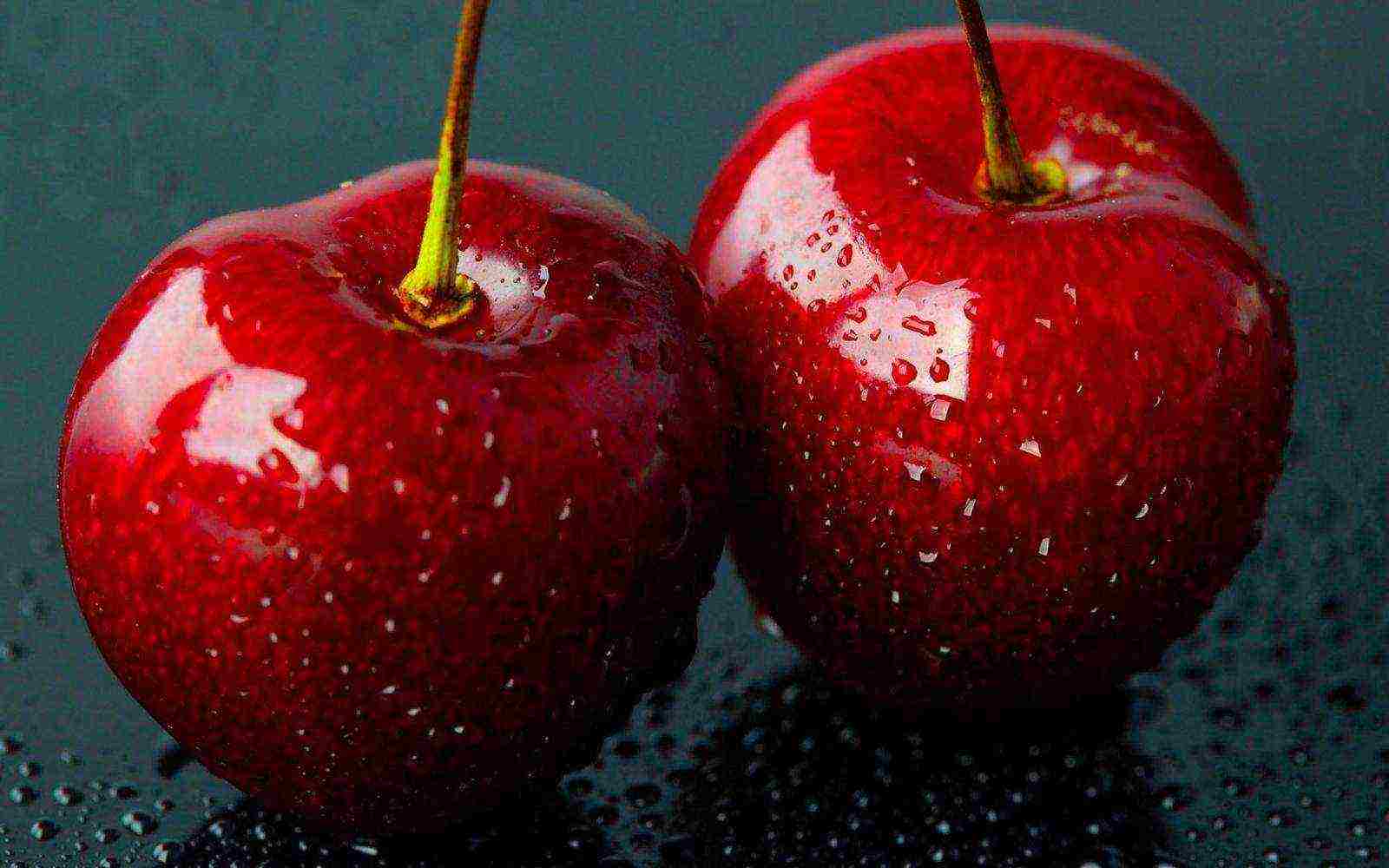
All modern cherries are descendants of sweet and wild cherries. Depending on the prevalence of a particular variety, it depends on what the shrub will be.
Low bush varieties are excellent for the northern strip of the country. They are well covered with snow and due to this they safely tolerate severe frosts. At the same time, many varieties give a large yield. For the southern regions, low-growing tree varieties are suitable, which have a long lifespan (about 25 years).
When choosing cherries, you should take into account that they are self-fertile. Most varieties are self-fertile. This means that they need a pollinator plant. On a private plot, it is better to grow 4-6 trees of different varieties so that they are pollinated and bear fruit regularly.
Popular cherry varieties for central Russia
Choosing the right seedling is not easy. More than one and a half hundred varieties are registered in the State Register. However, not all of them are able to withstand frosts and will yield crops in central Russia.
When buying a cherry seedling, you should pay attention to 4 important criteria:
- yield;
- frost resistance;
- ripening period of berries;
- resistance to various diseases and pests.
Next, we will analyze the best early, middle and late varieties of cherry trees that can be safely grown in the Central European part of the country.
Early
There are very few varieties that ripen at the beginning of summer and have good resistance to severe frosts. But this does not mean that you cannot taste ripe cherries already in June. Early varieties include:
Dessert Morozova
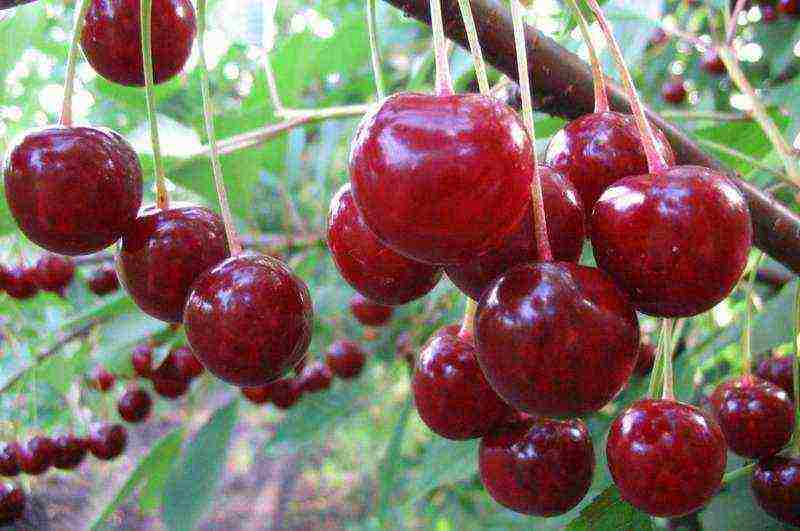
The fruits have a delicate sweet taste with a subtle sourness, medium-sized, round, dense, red. The pulp is juicy. The weight of one berry is 4.5-5 g, the sugar content is 13%. Productivity - 20 kg from one tree. The variety is medium-sized, has a round, medium-leafed crown. Fruiting occurs in the second half of July.
The cultivar is partially pollinated. The best pollinators will be such varieties as Griot Rossoshansky, Griot Ostgeimsky, Vladimirskaya and Studencheskaya.
Annushka
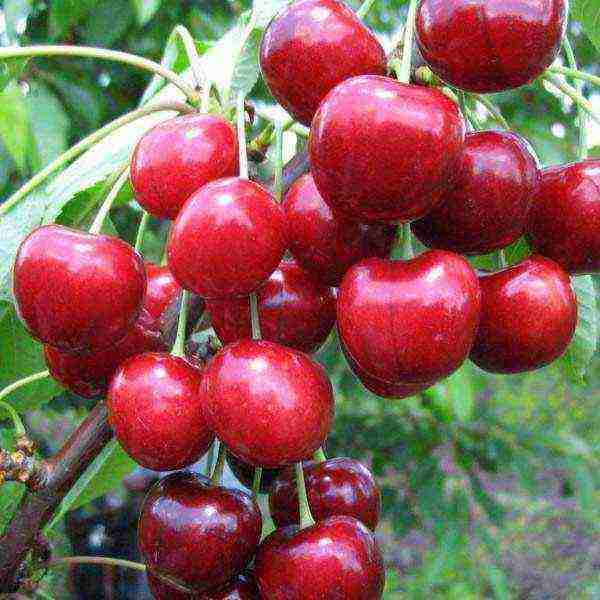
The berries have a pleasant sweet and sour taste, medium size, round shape. Color - from scarlet to dark red. The pulp is juicy and red. The weight of one cherry is 4.8-5 g, the sugar content is 11%. Productivity - 12-14 kg. The tree itself is medium-sized with a very spreading crown, it is winter-hardy. Ripens very early, already in mid-June.
Cherries are self-fertile. Recommended to be planted with various varieties of sweet cherries.
Nezyabka
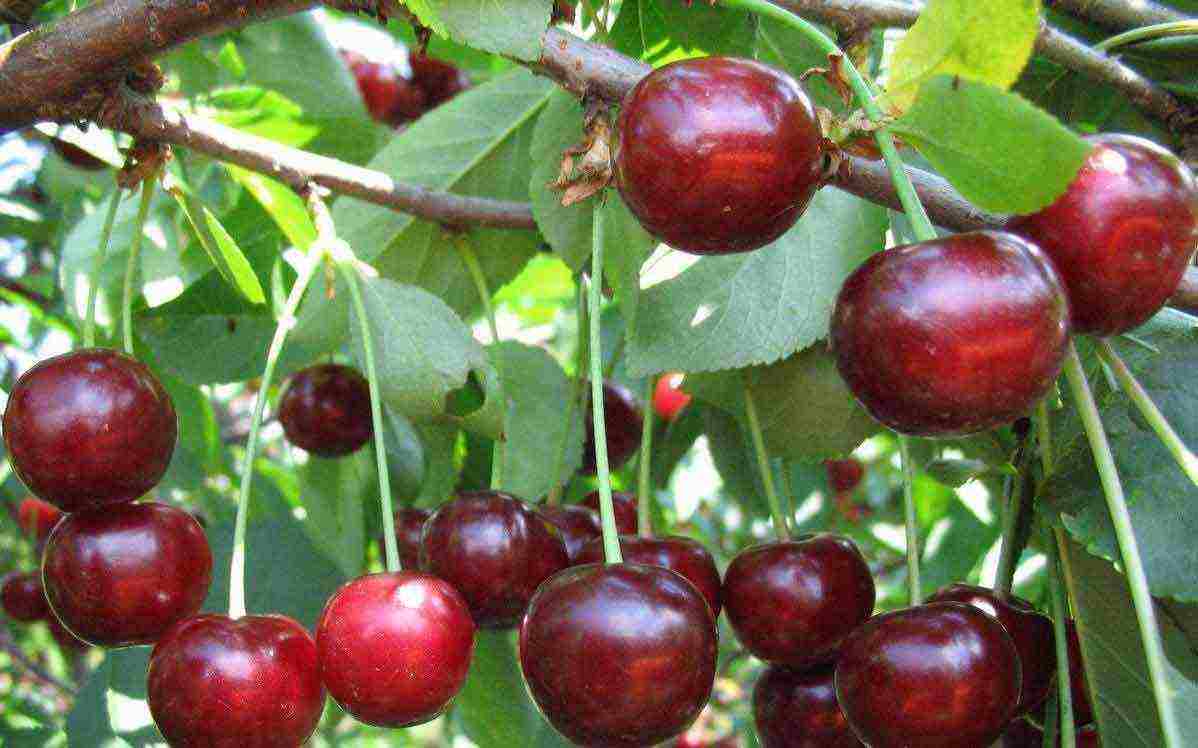
Cherries have a sweet taste with obvious sourness, the fruits are medium, bright red. The pulp is very juicy. The average fruit weight is 4.5 g, sugar content is 10%. The yield is good - 15-20 kg. The tree is tall, it can grow up to 2.5 m. The first harvest gives in the third decade of June.
The variety is self-fertile. The best pollinators will be Mayak, Krasa Tataria, Early Sweet.
Chocolate girl

The berries have a sour taste, the fruits are small, burgundy in color. The pulp is juicy and firm, with an easily detachable bone. Average berry weight - 3.5-4 g. Sugar content - 12%. Productivity - 15-17 kg. A mature tree can reach a height of 2.5 m. The crown has an average density. Begins to bear fruit at the end of June.
As an additional pollinator, it is recommended to plant the varieties Turgenevskaya, Studencheskaya, Lyubskaya and Vladimirskaya nearby.
Spunk
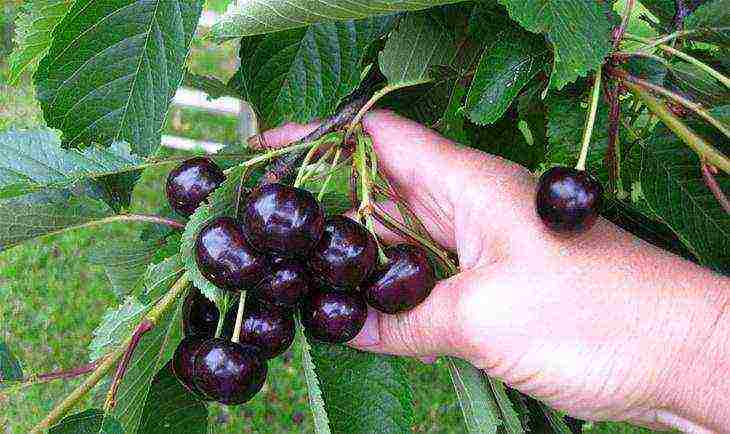
Cherries have a sweet and sour taste, the fruits are small in size, dark red, rounded-flattened. The pulp is juicy, red. Berry weight - 4-5 g. Sugar content - 11%. The yield is very high - 60 kg per tree. The tree itself is very tall, it can reach a height of 6 m. Crohn's have an average density.
The variety is self-fertile. The Shpanki yield is influenced by the Stoykaya and Griot Ostheimsky varieties.
Medium ripening
This is the largest group.Here are presented a huge number of varieties, both new breeding and proven ones with a long history. Many of them are quite popular among gardeners.
Here are the most common ones:
Tamaris

Cherries are sweet with a barely perceptible sourness, rather large, round in shape, the top is slightly flattened, of a dark cherry hue. The pulp is brightly colored, dense, has a delicate texture with a lot of juice. Weight - 3.8-5 g.
Sugar content - 12%. Productivity - up to 20 kg. The variety is low-growing, looks more like a shrub, can reach a height of up to 2 meters. The crown is of medium density and rounded. The first berries can be harvested in early to mid-August.
Tamaris is self-fertile. The average yield increases if pollinators are planted nearby - cherries Zhukovskaya, Turgenevka, Lyubskaya.
Lighthouse

The fruits are pleasant to the taste, very sweet, without sourness, dark red, round, rather large in size. The pulp is fleshy, red and very juicy. Weight is 5-6 g. Sugar content - 14%. The yield is very high - 15-25 kg. The lighthouse is a small spreading bush with an oval crown. Average leafiness. Ripening comes in the second half of July.
The self-fertility of the variety is partial. To get good yields, you need to plant pollinator varieties. For this purpose, Nizhnekamsk, Shakirovskaya, Worker of Tataria are suitable.
Nord-star
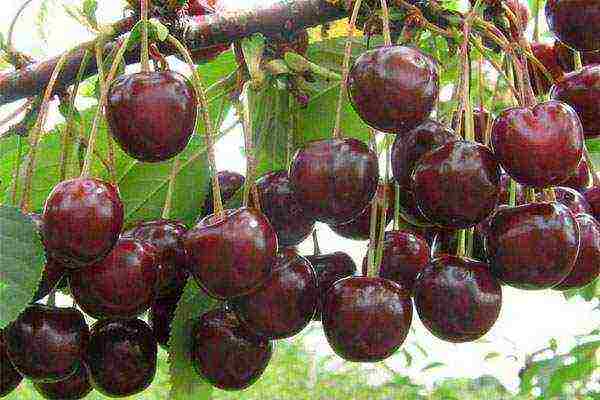
Cherries have a satisfactory sweet and sour taste, wide-rounded, medium to large in size, dark red in color. The pulp is juicy, medium density. Weight - 4-5 g. Sugar content - 9%. Productivity - 15-20 kg. Slightly growing tree with a compact, medium thickened crown. The first crop can be harvested in mid-July.
It is a partially self-pollinated variety. Recommended to plant with Nefris, Meteor, Oblachinskaya cherries.
Vladimirskaya
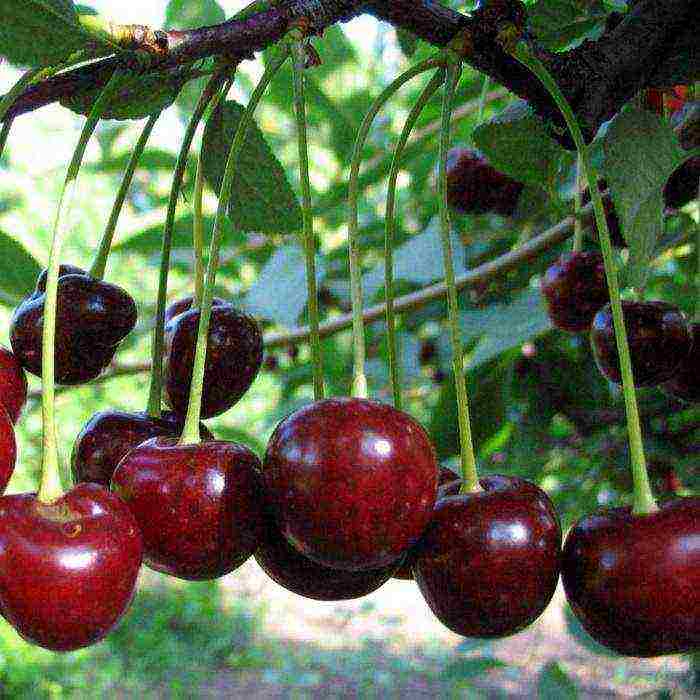
Fruits are sweet and sour, slightly fibrous, dark red almost black in color, small in size, have a rounded-flattened shape. The pulp is firm and juicy enough. Weight - 2.5-3.5 g. Sugar content - 10%. Productivity - up to 25 kg. The tree has a bushy shape, quite spreading, branches grow downward. Begins to bear fruit at the end of July.
The best neighbors for Vladimir cherry will be Black Consumer Goods, Rastunya, Fertile Michurina, Vasilievskaya.
Kharitonovskaya
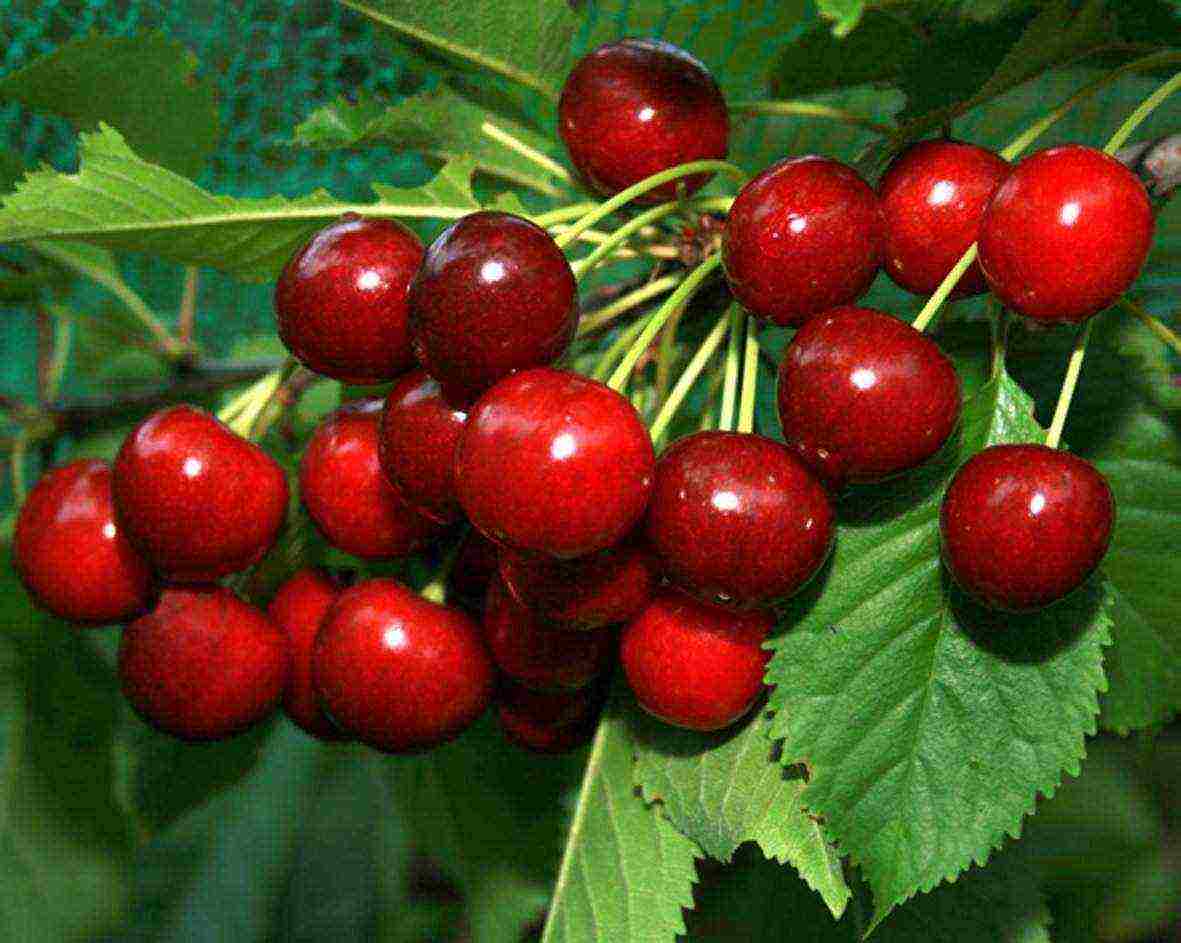
It has a sweet and sour taste, the berries are evenly rounded, bright red in color. The pulp is orange, the stone is easily separated, the juice is light red. Weight - 5 g. Sugar content - 11%. Productivity - 20-30 kg. The tree can reach a height of up to 3 meters. It should be noted that this variety grows very wide in width.
Needs additional pollination. The varieties Lyubskaya, Zhukovskaya and Vladimirskaya are perfect.
Late
This group attracts with its amazing resistance to frost and berries with an amazing taste. They rarely suffer from cold weather, therefore they give a very large harvest. Among the late varieties of cherries that are in demand, there are:
Turgenevka
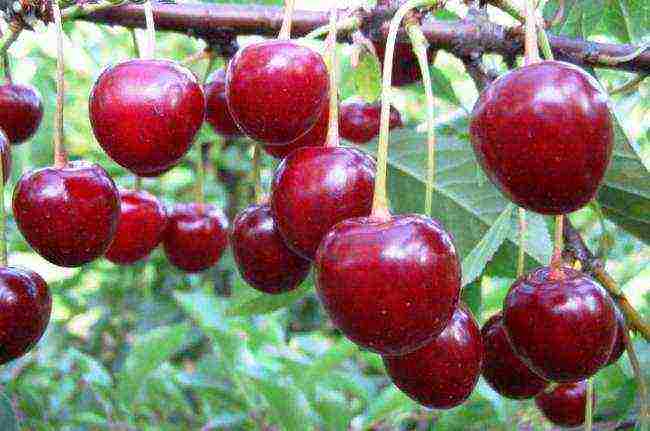
The fruits are sweet, slightly sour, rather large, slightly heart-shaped, have a deep dark red color. The pulp is juicy, brightly colored. Weight - 5 g. The sugar content is 13%. Productivity - 10-25 kg. The tree reaches a height of no more than three meters. The crown looks like an inverted pyramid with not very dense branches.
The Turgenevka variety needs pollinators. The varieties Favorit, Lyubsky, Molodezhny, Melitopol'skaya joy will cope with this task best of all.
Youth

The fruits are sweet, very large, oval, dark burgundy in color. The pulp is brightly colored, contains a large amount of juice. Weight - 5 g. Sugar content - 12%. Average yield - 10-12 kg. The variety is tree-like, undersized with a drooping crown. Ripening begins in the second decade of August.
Self-fertile tree. Morozovka, Turgenevka, Shubinka, Lyubskaya will become good neighbors for him.
Robin
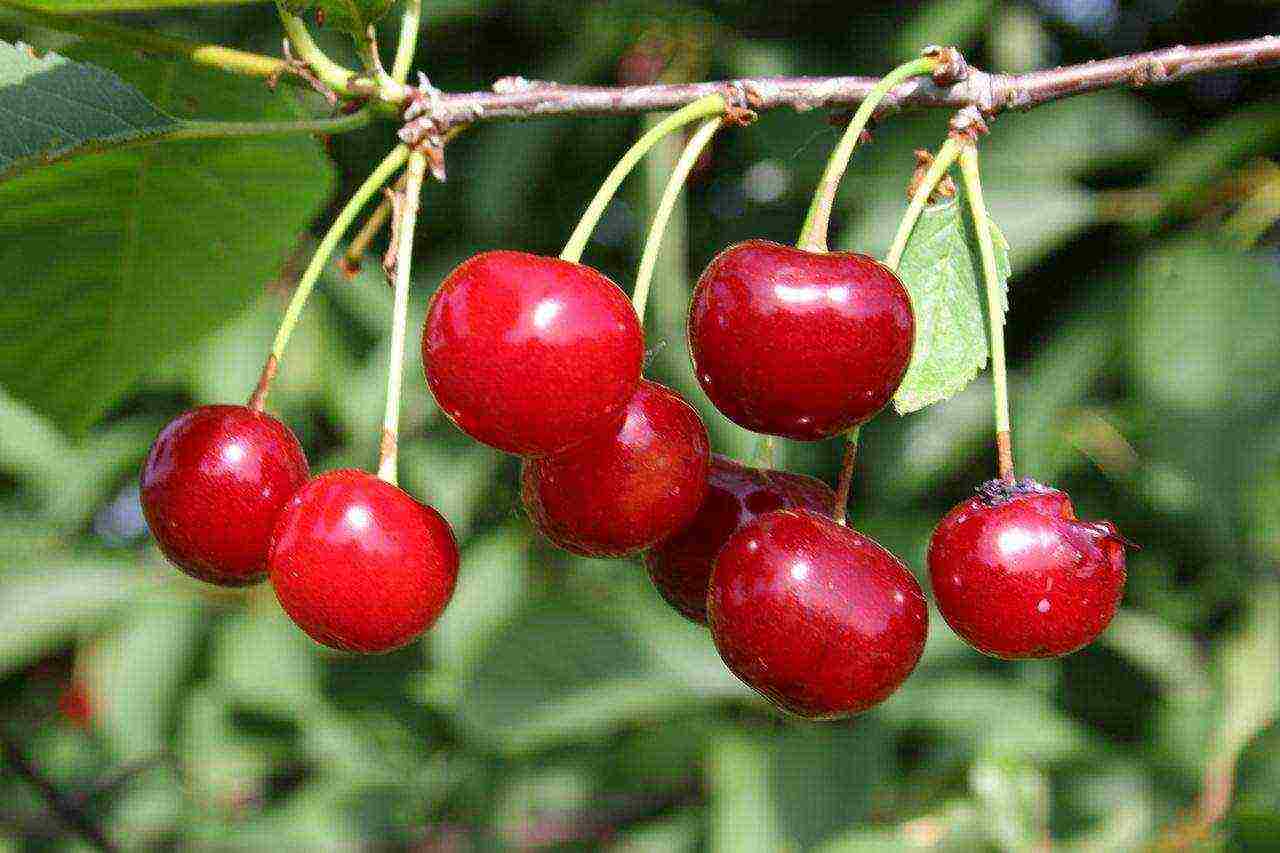
The berries have a pleasant sweet and sour taste, small, rounded, burgundy in color. The pulp is firm, with dark red juice.Weight - 3-3.5 g. Sugar content - 10%. The yield is high - 40-50 kg. The tree reaches a medium height, the crown is dense and rounded. Ripens late, around early August.
The robin needs additional pollinators. Next to it, the varieties Shubinka, Black Consumer Goods, and Lyubskaya should be planted.
Menzelinskaya
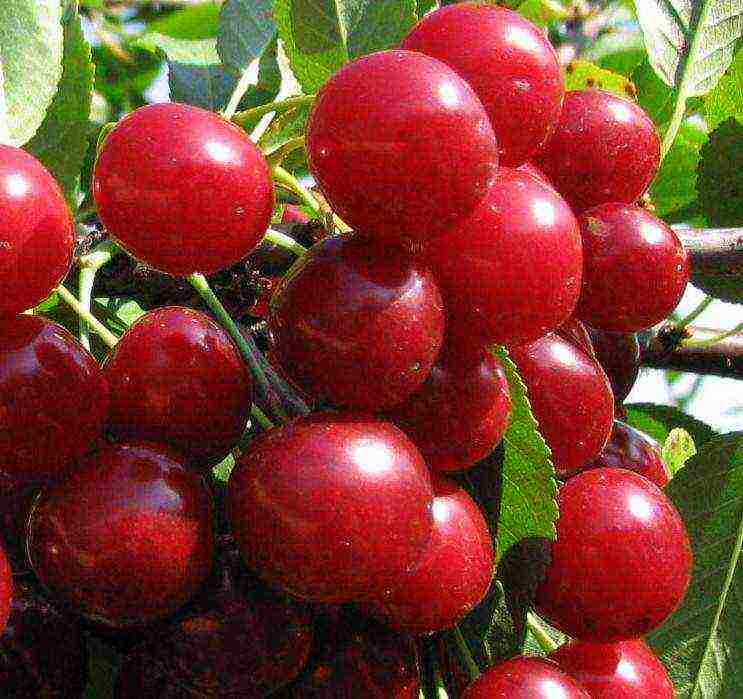
Fruits have a sweet and sour taste, medium in size, red in color. The pulp is firm and juicy. Weight - 4-4.7 g. Sugar content - 9%. Productivity - about 10 kg. The variety is bushy, quite spreading, reaches up to 2.5 m in height, has a weeping crown. The first crop can be harvested in mid-August.
The plant is self-fertile. Vladimirskaya and Shubinka cherries will be good pollinators.
You can grow a beautiful cherry orchard and ensure high yields by choosing the right varieties. Seedlings should be selected based on self-pollination.
The best winter-hardy cherry varieties for the middle lane

Growing cherries in the photo
To begin with, we present to your attention a photo and description of cherry varieties with increased winter hardiness.
Ukrainian. Comes from Vladimirskaya (Roditeleva). The tree or bush is strongly developed, with a hemispherical, widely spreading crown, with slightly hanging ends of the middle and lower branches. This cherry variety is winter-hardy, high-yielding, fast-growing, early. Propagated mainly by root suckers. Early flowering.
Fruiting on one-two-perennial wood, which differs from Vladimir (Roditeleva). Begins fruiting from the 3rd year. In the period of the highest yields (9-20 years) it gives 10-24 kg per tree on average, and from individual trees up to 40-50 kg.
Fruits are medium, about 3 g in weight, flat-round, dark purple, almost black, with dark pink pulp and thick dark red juice. The taste is good, sweet, with mild acidity. The stone is medium, flat-round, weight 0.26 g.
Fruits ripen at the beginning of July.
Consumption - fresh (the best dessert variety) and for technical processing: for wine, extracts, preserves and other products. Transportability is satisfactory.
Fertile Michurina. The tree is undersized, up to 2 m in height, with a wide spreading crown and hanging ends. This is one of the best winter-hardy cherry varieties with a high yield. Flowering and late ripening.
Begins fruiting from the 3rd year. The name of this cherry variety speaks for itself - this form is very fertile. In the period of increasing yields (4-9 years) it gives an average of 0.5-10 kg of fruits per tree, in the period of the highest yield - 12-16 kg per tree, and from individual trees - up to 20-25 kg.
The fruits are large, weighing about 4 g, rounded, dark red, with long stalks. The pulp is juicy, with pink juice, sweet and sour mediocre taste. The stone is large, oval, weight 0.35 g.
Fruit picking - mid - late August.
Consumption - fresh, but mainly for technical processing: for juices, wine, jelly, preserves, compotes.
Vladimirskaya (Poditeleva). A tree or shrub of moderate development, giving a spreading crown with drooping branches. The variety is winter-hardy, productive and fast-growing. Begins fruiting from the 3rd year. Early flowering. During the period of their growing harvests (4-8 years) it gives up to 8 kg of fruits per tree, during the period of the greatest harvests - 8-10 kg, and from individual trees - up to 30 kg.
As you can see in the photo, this cherry variety has medium fruits, about 3 g, flat-rounded, dark red, almost black.
The pulp is dark pink, with a thick, dark red juice, good, sweet, with mild acidity, taste. The stone is medium, flat-rounded, weighing 0.27 g.
Fruit ripening in early July.
The best variety for fresh consumption and technical processing: for wine, extracts, jellies, preserves, etc.
The best varieties of the largest cherry
Now check out the description of cherry varieties for central Russia, which are distinguished by the large size of the berries.
Here you can see photos of cherry varieties, the description of which is given below:
The beauty of the north. The variety was obtained by I.V.Michurin by crossing Vladimirskaya early cherry with white Winkler cherry.
The trees are vigorous, with a sparsely bunched oval spreading crown covered with large leaves.
The variety is medium winter hardy and medium-yielding in the conditions of the region, with early ripening of fruits. Begins fruiting from 3-4 years. At the age of full fruiting (12–20 years), it produces an average of 8–12 kg of fruit per tree. Flowering is medium late.
This is one of the best varieties of large cherries with fruits weighing about 5 g, light pink, flat-rounded, shiny, with soft, very juicy light pulp and juice of excellent, sweet-sour taste. The stone is large, round, weight 0.35 g.
Ripening - at the end of June, mass harvest - at the beginning of July, end of collection - in mid-July.
Not suitable for transportation. The best dessert variety. The fruits are good for jam, stewed fruit, etc.
Lyubskaya. One of the best Central Russian varieties. It has been known in the region for a long time, but it is not yet widespread.
A short tree, up to 2-2.5 m, with a hemispherical, medium-dense crown, covered with large dark green leaves.
The variety is medium-hardy. The main characteristic of this cherry variety is high yield and early maturity. It begins to bear fruit from the 3rd year, the yield grows quickly. In the period of increasing yields (4-9 years) it gives on average from 1.2 to 12 kg of fruits per tree, and in the period of the greatest harvests (10-20 years) - 16-30 kg. Blooming later.
Fruits are large, weighing 3.8 g, flat-rounded, dark red, with juicy pink-red pulp and juice of a sweet and sour mediocre taste. The stone is medium, round, weighing 0.27 g.
Fruits ripen on July 20-25, mass harvest - July 22-30, end of harvest on August 5-10. They tolerate transportation well.
Consumption - fresh, for technical processing (jams, wines, juices) and for homemade products - marinades, etc.
Large-fruited Volga... The tree is of medium vigor, with a rounded, medium spreading crown. The variety is winter-hardy and high-yielding, with a rapid increase in yields over the years. At the age of 7-8 years, it produces up to 10 kg of fruits.
This is one of the largest cherry varieties: its fruits reach 4-6 g, with an average weight of 4.5 g, oval-round, narrowed towards the apex, somewhat compressed from the side of the seam, maroon, with gloss. The pulp is dark red, like the juice, medium-dense, juicy, sweet and sour, good taste. The stone is large enough, weighing 0.3 g, lagging behind the pulp.
Fruit picking - in the second half of July.
Fresh consumption can also go for technical processing. In terms of winter hardiness, productivity, size and taste it surpasses a number of local varieties.
What variety of cherries can be planted on the site (with video)
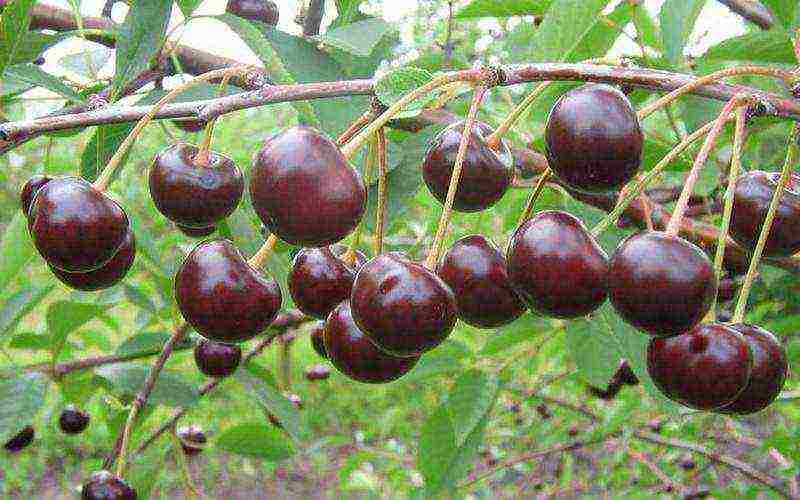
Cherry variety "Antonovka Kostychevskaya" in the photo
Antonovka Kostychevskaya (Kostychevskaya, Kostychevka)... A combined local variety of steppe cherry, obtained from its natural pollination with sour cherry.
Under this name, a number of varieties (clones) or varieties are found, from which the best are selected as a result of bedbug selection:
- Black Kostychevskaya (No. 1),
- Kostychevskaya number 2,
- Red kostychevka (No. 4) and
- Sweet kostychevka (No. 5).
Below is a description and characteristics of each of them.
Kostychevskaya black (Antonovka Kostychevskaya No. 1, Black Kostychevka)... A low tree or bush, with a broadly spreading hemispherical crown, arcuate curved branches, with which ends hang downward. Leaves of medium size, elongated, slightly curved, dark green, shiny.
Fruiting - on annual wood. This late cherry variety is suitable for the middle lane: it is highly winter-hardy and drought-resistant. The yield is high. Begins fruiting from the third year. Blooming later. In the period of full fruiting (10-25 years) it gives up to 18-24 kg per tree, and from individual trees 30-35 kg.
The fruits stay on the tree for a long time. Fruits are medium, weighing 3.2 g, rounded, slightly compressed from the sides, maroon, with black spots.The pulp is medium-dense, dark pink, with a thick dark pink juice, sour, with a barely perceptible bitterness and aroma typical of steppe cherries, of a mediocre taste. The stone is small, oval, weight 0.22 g. Fruit transportability is good.
The beginning of fruit picking - in the second half of July, the end - in the middle of August.
Consumption - fresh, but mainly for technical processing.
Kostychevskaya number 2 (Kostychevka). It differs from the previous variety in an almost rounded dense crown with non-hanging branches, dull leaves, wavy curved at the edges, and fruiting on one-two-year-old wood. The variety is winter-hardy, drought-resistant and productive. In the period of full fruiting (9-20 years) yields up to 20-20 kg per tree.
Fruits ripen in the second half of July, but somewhat earlier than that of Kostychevskaya No. 1. This variety of cherries, grown in Russia, is close to Kostychevskaya No. 1 in appearance and fruit quality.
Fruit consumption is the same.
Red Kostychevka (Kostychevka No. 4). A tree or shrub of medium development, with a broadly spreading crown and arcuate curved, hanging branches, the drooping of which is more pronounced than that of Kostychevskaya No. 1, with which it is similar in morphological features. This variety is winter-hardy. This cherry variety for central Russia with a high yield with a rapid increase in yield over the years. At full yields (9–20 years), it gives an average of 15–20 kg per tree, and from individual trees - 35–40 kg.
Fruits are medium, about 3 g in weight, almost round, slightly flattened from the poles, dark red (lighter than Kostychevskaya No. 1), sweet and sour good taste.
Ripen in the second half of July.
Fruit consumption - fresh and for technical processing.
Kostychevka sweet (Kostychevka No. 5). A small tree or shrub with an oval-rounded, medium spreading crown, with hanging lower branches. Branching is not dense. Winter hardiness is high. The yield is average. In the period of full yield (9-20 years) it gives 8-15 kg per tree, and from individual trees up to 20-25 kg.
The fruits are almost round, slightly compressed from the sides, dark red (lighter than Kostychevskaya No. 1), weighing about 3 g. This is one of the best cherry varieties for central Russia with a good, sweet and sour taste with low astringency. The stone is medium, elongated-oval, weighing 0.2 g.
Fruit picking - in the second half of July.
Consumption - fresh and for technical processing.
These photos show the best cherry varieties for central Russia:
Kostychevskaya black (No. 1) is zoned according to the group of the main varieties, and the rest - as additional and for wide production testing, in all zones of the region.
All varieties of Antonovka Kostychevskaya are propagated by grafting, but mainly by root suckers, which are pre-rooted in the nursery for planting in the garden (pereshkolka). The root system of all varieties is deep and gives a small number of offspring.
Watch the video "Cherry Varieties", which shows the best forms of this crop:
The nicest varieties of cherry wood
Below is another selection of photos and names of cherry varieties that many gardeners consider the best for growing on the site.
Rastunya (Rastunya, Dslgostebelka). Widespread Volga variety. Vigorous trees with a wide-pyramidal crown. The growing season ends late. They grow well and bear fruit on light to medium-textured soils, moderately moist and sufficiently nutritious. On fatty soils and in low places, the growth of trees increases, but their resistance to frost and gum flow is weakened.
This is one of the best cherry varieties for the middle lane, medium-hardy, fruitful. Begins fruiting from the 4th to 5th year. The harvest is distributed over the entire crown, mainly on two-three-year-old wood, on bouquet branches. In the period of the greatest harvests (10-25 years), an average of 25-35 kg are produced, and individual trees are 40-45 kg. Medium early flowering.
The fruits of this cherry tree variety are medium, their average weight is 2.6 g, flat-rounded, maroon-red, with juicy dark pink pulp and sour juice, refreshing taste. The stone is medium, round, weight 0.25 g.
Fruit ripening - July 10-15, mass harvest - July 15-20, the end of the harvest - the last days of July. The fruits are transportable.
Consumption - fresh and for technical processing, where this variety takes one of the first places.
Podbelskaya A local variety representing a hybrid form of steppe cherry of unknown origin.
It grows as a low bush or tree with a broadly spreading crown, the branches of which, curving in an arc-like manner, hang down at the ends. The variety is highly winter-resistant, drought-resistant and productive.
Begins to bear fruit from the age of three with a rapid increase in yields. At the time of full fruiting gives an average of 5-12 kg of fruit per bush, with the largest - 24-30 kg. Medium early flowering.
Fruits are of medium size, flat-rounded, bright red at the beginning of ripening, darker at full maturity. The height of the fruit is 1.4 cm, diameters are 1.63 and 1.45 cm, weight is 2.6 g. The pulp is juicy, light pink, the juice is pink. This cherry variety is considered the best by those who love the "classics": the taste of the fruit is sour or slightly sweet. The stone is oval-round, small, weight 0.23 g.
Ripening is medium late: removable maturity on July 20-25, mass harvest - July 25 - August 10, end of harvest - August 15-20.
Due to its firm attachment to the stalk, the fruit, after reaching removable maturity, can remain on the tree for a long time, acquiring the best taste and extending the fresh use period up to one month.
Consumption - fresh, but mainly for technical processing.
What varieties of cherries are best planted in the middle lane
If you do not know which varieties of cherries are best planted in the middle lane, pay attention to the following forms:
Chocolate girl. The trees are medium-sized, with a rounded, medium-spreading, well-leafy crown, of medium density.
It starts bearing fruit in the 3rd year after grafting. Annual yield, good; at the age of full harvests gives the front 16-18 kg per tree, and from individual trees - up to 26-30 kg.
The winter hardiness of the variety is insufficient - in more severe winters, frost damage to the branches is observed, as well as "burns" on the bark of the trunks. Medium early flowering.
Fruits are large, weighing 4 g, flat-round or onion, dark red, almost black, shiny, beautiful, one-dimensional in size and shape. The pulp is dark red, with dark juice, medium-dense, sweet, with mild acidity, excellent taste. The stone is medium, almost round, weighing 0.27 g.
Fruit ripening is medium early: the beginning of ripening is in the first ten days of July, mass consumption is in mid-July.
Duration of fresh fruit storage is about ten days. The best dessert variety, also used for technical processing.
You need to plant in more protected places. Suitable for production trials and in private gardens.
Novella. The tree is medium-sized, with a broad-pyramidal crown, winter-hardy. The variety is fast-growing. The yield is high, annual. Fruiting - both on annual wood, and two-perennial, which differs from both parents.
Fruits are medium, average weight 3.2 g, dark red, glossy, flat-rounded. The pulp is pink-red, juicy, soft, with red juice, sweet and sour, good taste, dessert quality. The stone is small - 0.21 g in weight, lagging behind the pulp.
Ripening - in the first half of July.
Consumption - fresh and for technical processing. Zoned in the Volga zone.
Flora. The tree is medium-sized, with an oval-rounded medium-spreading crown. Winter hardy. The yield is high, annual. Fruit bearing on annual and biennial wood.
Fruits are medium, weight 3 g, flat-rounded, dark red, glossy. The pulp is pink-red, juicy, soft, with red juice, sweet, with mild acidity, excellent taste. The stone is medium, weight - 0.25 g, lagging behind the pulp.
Ripening - in the first decade of July.
Consumption - fresh and for home processing.Zoned in the Volga zone of central Russia.
Description of the most delicious varieties of cherries
Victory. The tree is medium-sized, with a rounded, medium-spreading crown. Winter hardiness is high. A fast-growing variety - begins to bear fruit in the 2-3rd year after grafting, with a rapid increase in yields. The yield is high, annual: the first fruiting of the seedling (mother tree) in the 5th year was 0.5, the second — 1.5, the third — 3, and the fourth — 5.8 kg.
Fruits are medium, weighing about 3 g, round-conical, maroon-red, shiny. This is one of the most delicious cherry varieties with a juicy, medium-dense, pink-red pulp, with a thick dark red juice. Sweet, light acid, dessert quality. The stone is small - 0.18 - 0.20 g, lagging behind the pulp.
Fruits ripen in mid-July.
Mostly dessert variety. It can also go for technical processing. Recommended for testing in all areas of the middle lane.
Dawn of the Volga region. The tree is of medium growth, with an oval-rounded medium spreading crown. The variety is winter-hardy. The yield is high, with a rapid increase over the years: in the first fruiting in the 5th year of sowing, it gave 0.3 kg, in the second year - 1 kg, in the third fruiting - 1.9 kg, in the fourth - 6.5 kg, at 10 m year (7th fruiting) - about 12 kg per tree.
The fruits are large, with an average weight of 4.5 - 5 g, flat-rounded, light pink, resembling the Beauty of the North. This is a very tasty cherry with a juicy, soft, light pulp, sweet and sour taste. The stone is medium, weighing 0.25 g, lagging behind the pulp.
Fruits ripen early - end of June - first decade of July.
The main purpose of the variety is dessert.
Amorel pink (Amorel early, Amorel). The variety is not very widespread. Trees of medium development, with a rounded medium spreading crown. In the conditions of the region, the variety is moderately hardy, productive and fast-growing, with early ripening of fruits. Begins fruiting from the 3rd year. At the age of 10-18 years, it yields from 8 to 20 kg of fruits per tree. The fruits on the tree hold firmly and, when removed, often the seeds remain on the petiole, therefore, at the first harvest, they are cut with scissors.
The fruits are large, their average weight is 3.5 g, flat-round, bright red, with light pulp and juice of a good, sweet and sour taste. The stone is medium, round, weight 0.24 g. Transportability is low.
Fruit ripening - from June 15-20, mass harvest - June 20-30, end of harvest - July 5-10.
Consumption - mainly fresh.
Look at a selection of photos of the best varieties of cherries for growing on a personal plot:
Rate the article:
(7 votes, average: 4.4 out of 5)
